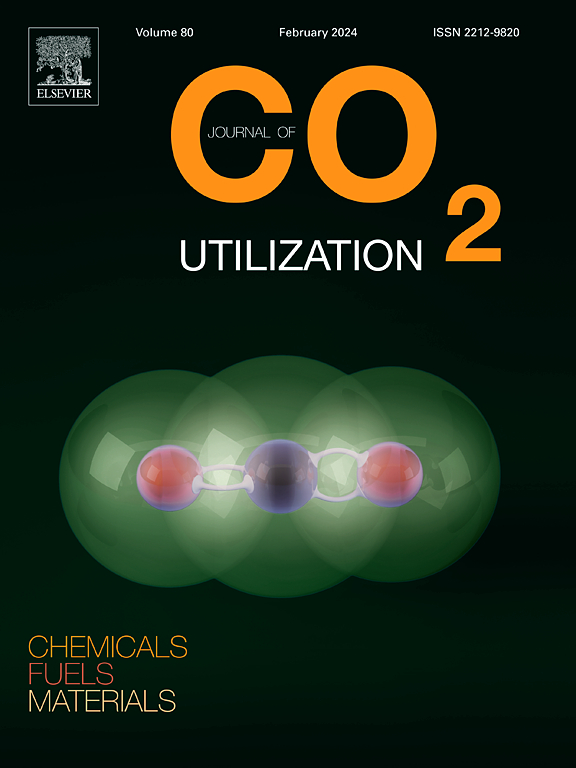改善PMMA/Matrimid@5218/氧化石墨烯混合基质膜的气体分离性能
IF 7.2
2区 工程技术
Q1 CHEMISTRY, MULTIDISCIPLINARY
引用次数: 0
摘要
在最近的膜研究中,寻找具有超越罗布森上限的特殊分离性能的物理化学稳定膜引起了相当大的关注。为此,使用聚合物共混和混合基质膜(MMMs)在改善膜性能方面显示出希望。在本研究中,我们将聚(5氨基-1-(4氨基苯基)-1,3-三甲基茚)(Matrimid@5218)掺入聚(甲基丙烯酸甲酯)(PMMA)聚合物基体中,制备了一种共混膜,以利用Matrimid的高机械强度和热稳定性,以及PMMA合适的渗透性和选择性。随后,将氧化石墨烯(GO)嵌入到这种共混膜中,以探索这些新型MMMs的气体分离性能,重点研究He/N2、He/CH4、CO2/N2和CO2/CH4的分离。在确定了最佳聚合物共混物组成后,在不同压力(2-10 bar)和温度(35℃)下,对不同填料含量的mmmm进行了气体渗透实验。采用FTIR、DSC、TGA、SEM、XRD、拉伸测试等综合表征技术对制备的膜进行了表征。结果表明,PMMA/10 %Matrimid/1 %GO对He/N2和He/CH4的分离效果最好。值得注意的是,纯PMMA膜的He渗透率从12.83 Barrer增加到PMMA/ %Matrimid/1 %GO的21.19 Barrer(约65 %)。PMMA/10 %Matrimid/1 %GO的He/N2和He/CH4选择性分别达到857.9和1033.66。另一方面,PMMA/10 %Matrimid/2 %GO是CO2/N2和CO2/CH4分离的最佳MMM。该MMM的CO2渗透率、CO2/N2和CO2/CH4选择性分别为14.23 Barrer、729.74 Barrer和862.42 Barrer。与CO2渗透率为1.08 Barrer, CO2/N2选择性为31.76,CO2/CH4选择性为83.07的纯PMMA膜相比,PMMA/Matrimid/GO MMM系列具有进一步研究工业气体分离的良好前景。本文章由计算机程序翻译,如有差异,请以英文原文为准。
Improved gas separation performance of PMMA/Matrimid@5218/graphene oxide (GO) mixed matrix membranes
In recent membrane research, the search for physicochemically stable membranes with exceptional separation properties surpassing the Robson upper limit has attracted considerable attention. For this purpose, the use of polymer blending and mixed matrix membranes (MMMs) has shown promise in improving membrane performance. In this study, we fabricated a blend membrane by incorporating Poly (5 amino-1-(4 aminophenyl)-1,3-trimethyl indane) (Matrimid@5218) into the poly(methyl methacrylate) (PMMA) polymer matrix to harness the positive properties of Matrimid, such as high mechanical strength and thermal stability, along with the suitable permeability and selectivity of PMMA. Subsequently, graphene oxide (GO) was embedded into this blend membrane to explore the gas separation properties of these new MMMs, focusing on He/N2, He/CH4, CO2/N2, and CO2/CH4 separations. After identifying the optimal polymer blend composition, gas permeation experiments were conducted on MMMs with varying filler loadings at different pressures (2–10 bar) and temperature (35 ºC). Comprehensive characterization techniques, including FTIR, DSC, TGA, SEM, XRD, and tensile testing, were employed to assess the prepared membranes. The results revealed that PMMA/10 %Matrimid/1 %GO exhibited the highest performance for He/N2 and He/CH4 separations. Notably, the He permeability increased from 12.83 Barrer for the pure PMMA membrane to 21.19 Barrer in PMMA/10 %Matrimid/1 %GO (about 65 %). Also, He/N2 and He/CH4 selectivities of PMMA/10 %Matrimid/1 %GO reached 857.9 and 1033.66. On the other hand, PMMA/10 %Matrimid/2 %GO emerged as the optimal MMM for CO2/N2 and CO2/CH4 separation. This MMM exhibited CO2 permeability, CO2/N2, and CO2/CH4 selectivities of 14.23 Barrer, 729.74, and 862.42, respectively. Comparing these results to the pure PMMA membrane with CO2 permeability of 1.08 Barrer, CO2/N2 selectivity of 31.76, and CO2/CH4 selectivity of 83.07, PMMA/Matrimid/GO MMM series were good candidates for further investigation in industrial gas separations.
求助全文
通过发布文献求助,成功后即可免费获取论文全文。
去求助
来源期刊

Journal of CO2 Utilization
CHEMISTRY, MULTIDISCIPLINARY-ENGINEERING, CHEMICAL
CiteScore
13.90
自引率
10.40%
发文量
406
审稿时长
2.8 months
期刊介绍:
The Journal of CO2 Utilization offers a single, multi-disciplinary, scholarly platform for the exchange of novel research in the field of CO2 re-use for scientists and engineers in chemicals, fuels and materials.
The emphasis is on the dissemination of leading-edge research from basic science to the development of new processes, technologies and applications.
The Journal of CO2 Utilization publishes original peer-reviewed research papers, reviews, and short communications, including experimental and theoretical work, and analytical models and simulations.
 求助内容:
求助内容: 应助结果提醒方式:
应助结果提醒方式:


